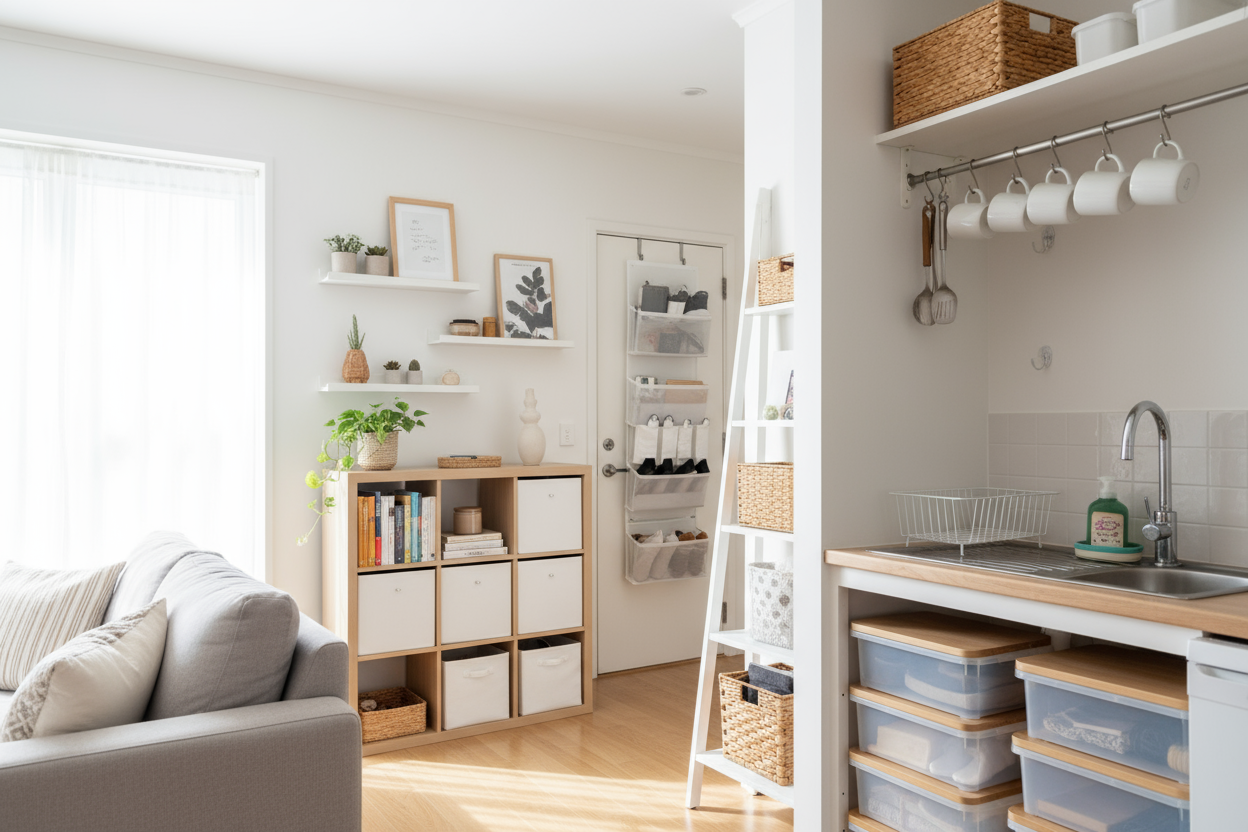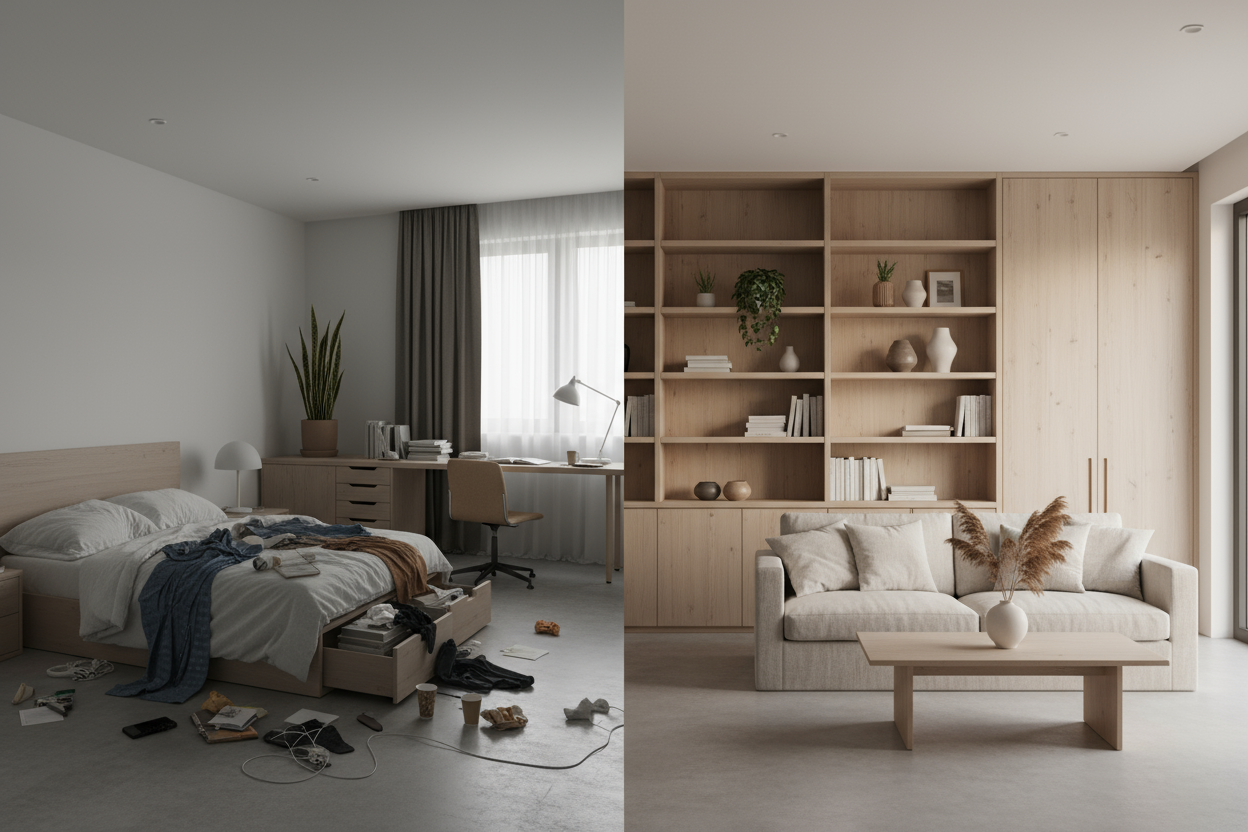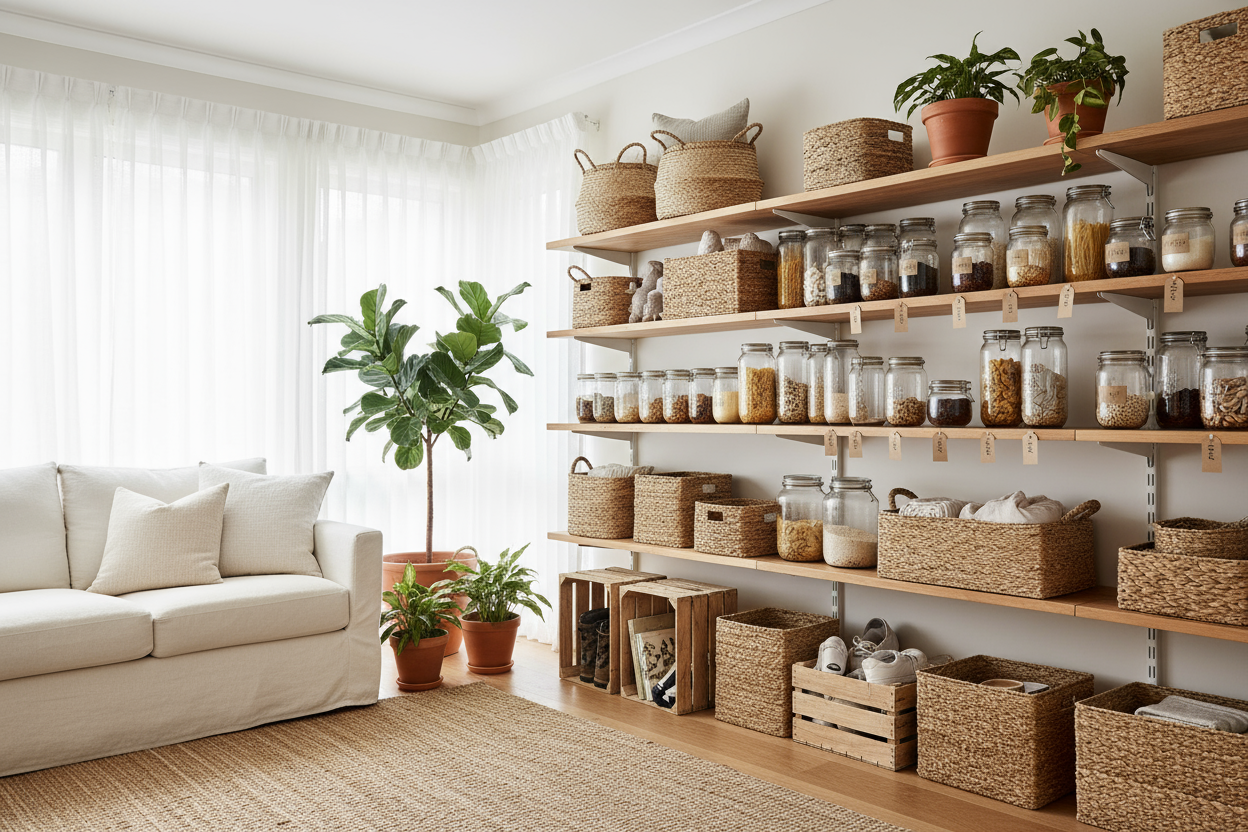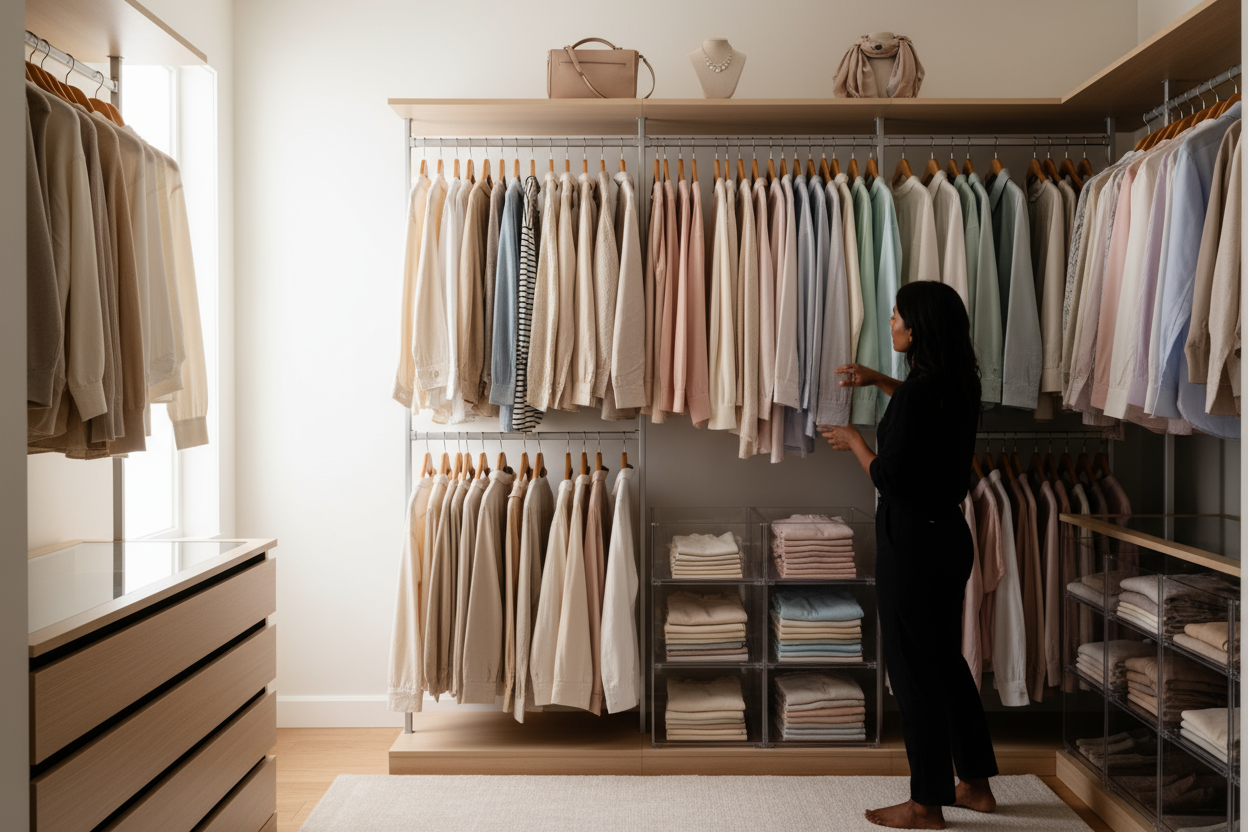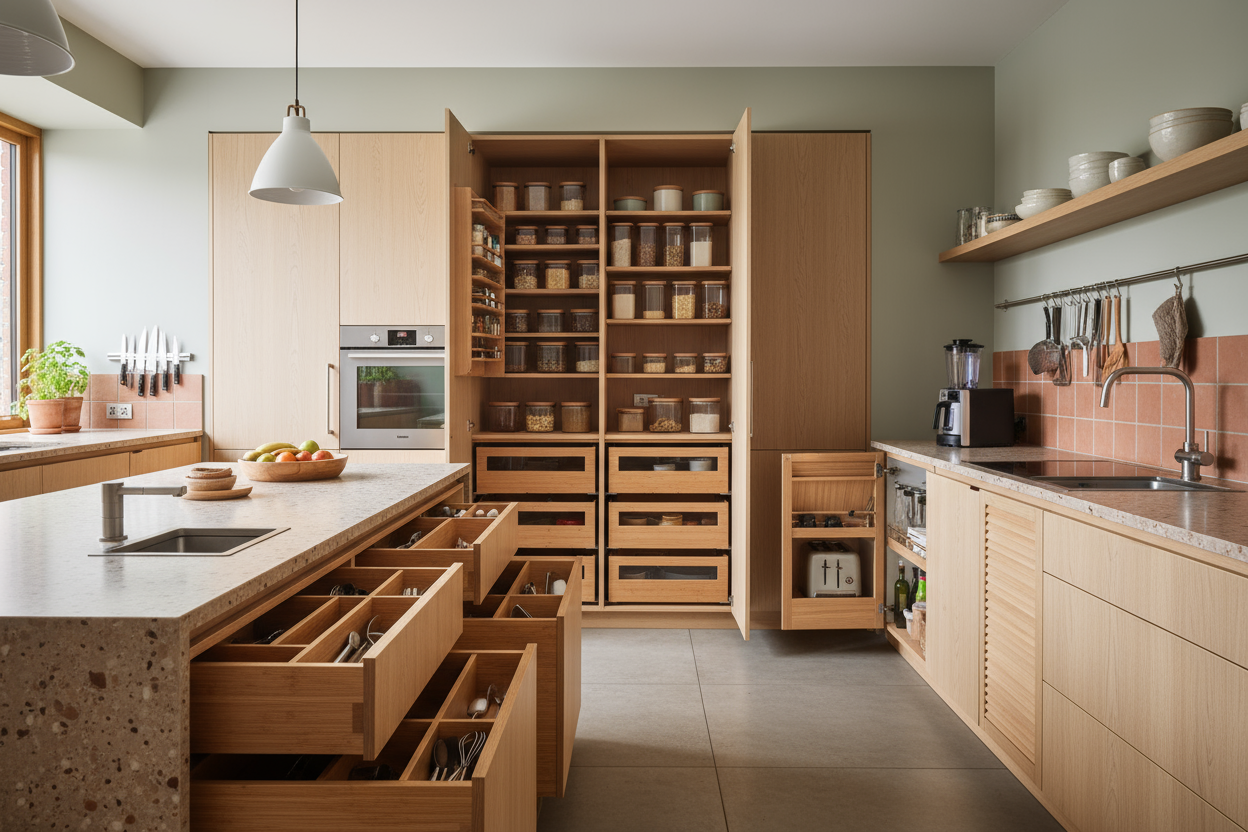Finding effective rental property storage without losing your bond deposit is one of the biggest challenges for Australian renters. Most lease agreements strictly limit modifications, leaving you to navigate the tricky balance between creating functional storage space and avoiding costly repairs. The good news is that smart storage strategies can transform your rental into an organised, liveable space while keeping your deposit intact.
Whether you're dealing with a tiny apartment or a house with limited built-in storage, the right approach makes all the difference. Understanding which storage methods work reliably, which ones to avoid, and when exceptions might apply can save you from expensive surprises at the end of your tenancy.
Why Traditional Storage Methods Fall Short for Renters
Built-in shelving and permanent fixtures aren't options when you're renting, but many popular "damage-free" alternatives come with their own problems. Command strips and adhesive hooks have strict weight limits that make them unsuitable for storing books, kitchen items, or anything substantial. When overloaded, these products often fail spectacularly, potentially damaging walls and disturbing neighbours with sudden crashes.
The weight restrictions on adhesive storage solutions are more limiting than most people realise. Even lightweight items can accumulate beyond the safe load capacity, leading to shelf collapses that create noise complaints and leave adhesive residue or paint damage that's harder to fix than small nail holes.
Floating shelves marketed as "damage-free" face similar limitations. While they might work for displaying a few decorative items, they're not practical for everyday storage needs like toiletries, cleaning supplies, or household essentials that have real weight.
The Small Holes Strategy: When It Makes Sense
Experienced renters often find that carefully placed small holes, properly patched before moving out, cause fewer problems than failed adhesive solutions. This approach requires confidence in your repair skills and a good understanding of your lease terms, but it can provide much more reliable storage.
Small nail holes from picture hanging nails or micro fixtures are typically easier to patch with spackle and matching paint than repairing wall damage from failed command strips. The key is keeping holes minimal, using the right repair techniques, and ensuring paint matches perfectly.
When Small Holes Are Worth Considering
This strategy works best when you're confident in your DIY repair skills and have a longer-term lease. Check your rental agreement first, as some leases explicitly allow holes up to a quarter-inch diameter for hanging pictures and light fixtures. If your agreement includes this provision, you have more flexibility for storage solutions.
Note: Always verify hole allowances and repair expectations with your lease or tenancy authority, as clauses vary. (insert peer-reviewed citation)
Angled micro nails can support light shelving with minimal wall impact, while products designed for renters often leave only small, easily patched marks. The repair process involves filling holes with appropriate spackle, sanding smooth when dry, and applying matching paint in thin layers.
Freestanding Storage Solutions That Work
The safest approach for most renters involves investing in quality freestanding storage that doesn't require any wall attachments. Open bookshelves, storage towers, and modular systems can provide substantial storage capacity while remaining completely reversible.
These solutions often cost more upfront but move with you to future rentals and eliminate any risk to your bond. Look for pieces that maximise vertical space without requiring wall mounting, and consider how they'll fit in different room layouts if you move frequently.
Portable wardrobe storage options work particularly well for renters with limited closet space, offering hanging storage, shelving, and organisation without requiring any installation.
[collection-carousel="wardrobe-storage"]
Maximising Vertical Space Safely
Tall, narrow storage units make efficient use of floor space while reaching toward the ceiling for maximum capacity. Storage towers with multiple compartments work well in bedrooms, bathrooms, and living areas without requiring any wall attachment.
For items you don't need daily access to, consider under-bed storage solutions that slide out easily when needed. These completely hidden storage options keep seasonal items, extra bedding, or rarely used belongings organised without taking up visible space.
[collection-carousel="under-bed-storage"]
Door and Surface-Mounted Options
Doors offer valuable storage real estate that doesn't require wall modifications. Over-door hooks and organisers hang from the top of doors without any hardware installation, making them perfect for rental properties.
[collection-carousel="over-door-hooks"]
These solutions work on bedroom doors for clothing, bathroom doors for towels and toiletries, and pantry doors for cleaning supplies or kitchen items. The key is ensuring door clearance and weight distribution to avoid damaging door frames or hinges.
Suction-based storage provides another no-damage option, particularly effective in bathrooms where smooth tile surfaces offer good adhesion. Suction bathroom storage can hold toiletries, cleaning supplies, and personal items without any permanent installation.
[collection-carousel="suction-bathroom-storage"]
Making the Most of Existing Fixtures
Look for storage opportunities around existing fixtures like towel bars, shower curtain rods, and cabinet handles. Hanging organisers designed to work with these fixtures add storage capacity without any modifications.
Tension rods between walls or inside cabinets create hanging storage for cleaning supplies, spray bottles, or lightweight items. These require no permanent installation but provide functional organisation in narrow spaces.
Room-by-Room Storage Strategies
Laundry Areas
Laundry spaces often lack adequate storage for detergents, cleaning supplies, and equipment. Freestanding laundry storage solutions can organise these essentials without requiring shelving installation.
[collection-carousel="laundry-storage-solutions"]
Rolling carts work particularly well in laundry areas, providing mobile storage that moves aside when you need floor access for larger items. Look for options with multiple tiers and side hooks for additional capacity.
Small Bathrooms
Bathrooms present unique storage challenges with limited floor space and high humidity. Combining over-toilet storage cabinets, suction organisers, and door-mounted solutions creates comprehensive storage without permanent modifications.
Freestanding corner units maximise unused space while keeping toiletries organised and accessible. Choose materials that handle bathroom humidity well and clean easily.
Kitchen Organisation
Kitchen storage needs often exceed cabinet capacity, but rental restrictions limit your options. Rolling kitchen carts provide additional counter space and storage while remaining completely portable.
Magnetic strips on refrigerator sides can hold spices, knives, or small tools without any installation. Inside cabinet doors, adhesive hooks or slim organisers add storage for lightweight items without modifying the structure.
Safety Considerations and Legal Exceptions
Some storage modifications may be legally justified even in strict rental agreements when safety is involved. Anchoring tall furniture to prevent tipping, particularly in homes with children, represents a safety requirement that may override standard modification restrictions.
This information should be cross-checked with your local tenancy authority or safety guidelines. (insert regulatory citation)
If you need to secure furniture for safety reasons, document this necessity and communicate with your landlord or property manager. Many will approve safety-related modifications, especially when you offer to restore walls upon moving out.
Always check your specific lease agreement and local tenant rights, as regulations vary across Australian states and territories. When in doubt, get written permission before making any modifications, even small ones.
Moving Out: Restoration Best Practices
If you've made any modifications during your tenancy, thorough restoration is essential for protecting your bond. This means having matching paint on hand, quality spackle, and the skills to make repairs invisible.
Take photos of walls before making any changes, and document your repair work with after photos. This evidence can protect you if disputes arise during the bond inspection process.
Professional repair may be worth the cost for complex damage or if you're unsure about your DIY skills. The expense of proper restoration is typically much less than losing your bond deposit.
Timeline for End-of-Lease Restoration
Start restoration work at least two weeks before your final inspection to allow time for paint to cure and any touch-ups needed. Small holes need 24 hours to dry after spackling, plus additional drying time for paint layers.
Remove all temporary storage solutions and clean thoroughly around former mounting areas. Even damage-free solutions can leave marks that need cleaning for the best presentation during inspection.
Making Smart Storage Investments
Quality freestanding storage pieces represent investments that move with you through multiple rentals. Focus on versatile, well-built items that adapt to different room layouts and storage needs.
Consider the cost per use over time when evaluating storage solutions. A well-made storage tower might cost more initially than temporary solutions, but it provides reliable organisation for years without bond risk.
Modular storage systems offer particular value for renters, as components can reconfigure for different spaces and needs. Look for systems that expand or contract based on your current rental's storage challenges.
What to Do Next
Start by assessing your current rental's storage limitations and identifying the most critical organisation needs. Prioritise solutions that address daily frustrations while keeping bond protection as the primary consideration.
Measure your spaces carefully before purchasing storage solutions, and consider how pieces will work in future rentals if you move frequently. Focus on flexible, quality options that provide long-term value rather than quick fixes.
Remember that effective rental storage often combines multiple approaches. Door storage, freestanding units, and creative use of existing fixtures can work together to create comprehensive organisation without lease violations.
The right storage strategy transforms rental living from chaotic to comfortable while protecting your financial interests. With careful planning and quality solutions, you can create the organised home you want without risking your bond deposit.


